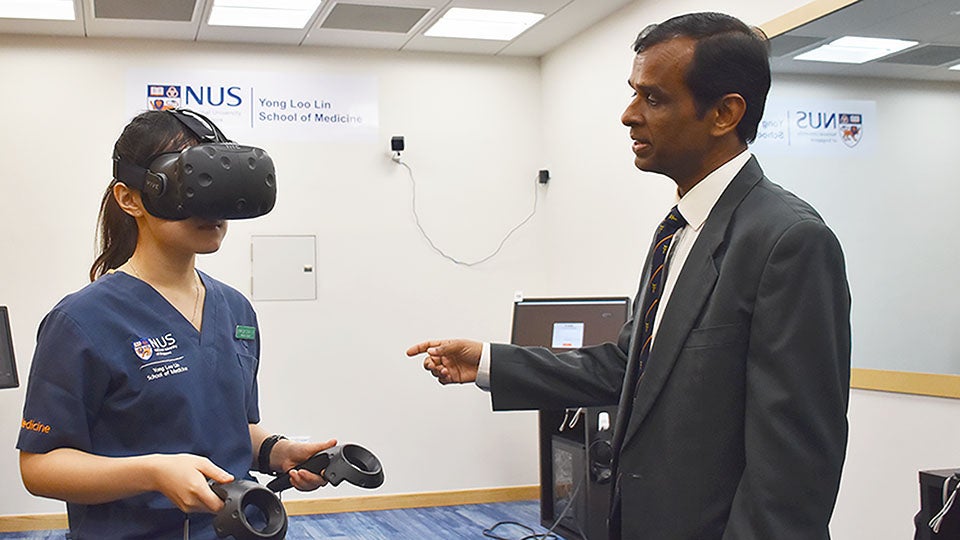NUS medical students get exposure to mass casualty incidents
Published: 07 Jun 2019

Medical students at the NUS Yong Loo Lin School of Medicine can now put their knowledge and skills to the test as members of a medical emergency response team operating in various mass casualty incident scenarios, through a virtually simulated environment.
This is made possible through the School’s introduction of the Virtual Interactive Simulation Environment (VISE) system at the Centre for Healthcare Simulation.
A part of the VR medical simulation project developed jointly by NUS Medicine and researchers from the Smart Systems Institute in NUS, this new supplementary learning system is native to NUS and Singapore. Beginning first with the development of the Virtual Interactive Human Anatomy (VIHA) three years ago, which enabled students to learn about human anatomy in great detail and depth, VISE is the next step forward in the application of VR technology for medical teaching and learning, said the School’s Vice-Dean for Education, Associate Professor Lau Tang Ching.
A powerful learning tool
The three-dimensional, virtual casualty management system enhances the teaching and learning of situational patient management, added Centre director and Principal Investigator of the project, Associate Professor Suresh Pillai. “VISE lets multiple learners be immersed in various mass casualty situations where they experience high-resolution stereoscopic displays of realistic casualties in an authentic environment complete with multi-modal sensory and auditory stimuli.”
“This new learning tool provides invaluable experience to our students, as mass casualty situations are laborious and costly to recreate in the real environment. But by harnessing the power of VR technology, they get to test learned skills and knowledge in mass casualty triage within a controlled environment, while gaining some appreciation for the complexities of operating as a team in a very demanding situation,” added Assoc Prof Suresh. He is a senior consultant at the National University Hospital’s Emergency Department.
In VISE, students don VR headsets and wield hand-held controllers to interact with each other in real-time as they manage multiple casualties. Their physical movements and actions are tracked and displayed in real-time for visualisation and evaluation. The students are able to conduct a host of assessments with the simulated casualties, including assessing and opening airways, evaluating breathing, assessing circulation by determining capillary refill time and pulse rate and assessing the physical disability status of the casualties. These actions underscore standardised and universally-practiced mass casualty triage protocols.
In order to ensure survival of as many casualties as possible in such situations, healthcare providers have to prioritise casualties according to the severity of their injuries. This process, known as triage, centres around making quick and effective decisions when the number of casualties outstrip available resources. VISE scenarios feature such casualties, challenging students to appreciate the dilemma faced by rescuers who must decide who can and should be saved in a major crisis.
Potential for more applications
The VISE system also features an in-built self-evaluation component that lets learners evaluate their actions, while also providing immediate feedback to learners on the accuracy of their actions. This was one of the major considerations during the development of the system – that users become independent, self-motivated learners in keeping with the principles of Andragogy or Adult Learning. VISE’s carefully integrated elements thus ensure maximum interaction and feedback loops to ensure high student engagement.
“The initial feedback from pilot studies amongst medical students have been very encouraging and we believe that this sort of experiential learning is integral in helping to enhance and reinforce the didactic curriculum. VISE will not be limited to healthcare students but can be developed to include scenarios for more advanced healthcare practitioners. We also hope to extend the use of VISE to other healthcare providers, including the all-important pre-hospital personnel from the SCDF as well as military personnel from the SAF,” Assoc Prof Pillai said.
With the development of the first VISE system, there are plans for more scenarios to be progressively added to the module. Possible future scenario depictions include managing multiple casualties in an Emergency Room and Operating Theatre, as well managing Infectious Disease Pandemics.
Read the press release here.
News Coverage


